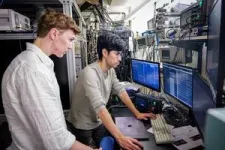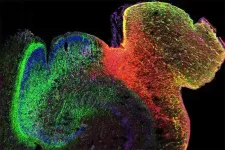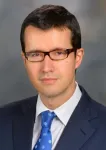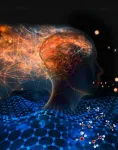(Press-News.org) Imagine walking into a room where several different grandfather clocks hang on the walls, each ticking at a different pace.
Quantum physicists at the University of Colorado Boulder and the National Institute of Standards and Technology (NIST) have essentially recreated that room at the scale of atoms and electrons. The team’s advancement could pave the way for new kinds of optical atomic clocks, devices that track the passage of time by measuring the natural “ticking” of atoms.
The group’s new clock is made from a few dozen strontium atoms trapped in a lattice pattern. To improve the device’s performance, the team generated a type of ghostly interaction, known as quantum entanglement, between groups of those atoms—basically squishing four different kinds of clocks into the same time-keeping apparatus.
It’s not your ordinary pocket watch: The researchers showed that, at least under a narrow range of conditions, their clock could beat a benchmark for precision called the “standard quantum limit”—what physicist Adam Kaufman refers to as the “Holy Grail” for optical atomic clocks.
“What we’re able to do is divide the same length of time into smaller and smaller units,” said Kaufman, senior author of the new study and a fellow at JILA, a joint research institute between CU Boulder and NIST. “That acceleration could allow us to track time more precisely.”
The team’s advancements could lead to new quantum technologies. They include sensors that can measure subtle changes in the environment, such as how Earth’s gravity shifts with elevation.
Kaufman and his colleagues, including first author Alec Cao, a graduate student at JILA, published their findings Oct. 9 in the journal Nature.
Lassoing atoms
The research represents another major advancement for optical atomic clocks, which can do a lot more than tell time.
To make such a device, scientists typically begin by trapping and chilling a cloud of atoms down to frigid temperatures. They then zap those atoms with a powerful laser. If the laser is tuned just right, electrons orbiting those atoms will jump from a lower energy level to a higher energy level, then back again. Think of it like the pendulum of a grandfather clock swinging back and forth—only these clocks tick more than a trillion times per second.
They’re extremely precise. The newest optical atomic clocks at JILA, for example, can detect the change in gravity if you lift them up by just a fraction of a millimeter.
“Optical clocks have become an important platform in many areas of quantum physics because they allow you to control individual atoms to such a high degree—both where those atoms are, and also what states they’re in,” Kaufman said.
But they also have a big drawback: In quantum physics, things as small as atoms never behave exactly like you’d expect. These natural uncertainties set what seems to be an unbreakable limit on just how precise a clock can get.
Entanglement, however, could provide a workaround.
Fluffy orbits
Kaufman explained that when two particles become entangled, information about one of them will automatically reveal information about the other. In practice, entangled atoms in a clock behave less like individuals and more like a single atom, which makes their behavior easier to predict.
In the current study, the researchers generated this kind of quantum link by nudging their strontium atoms so that their electrons orbited far away from their nuclei—almost as if they were made of cotton candy.
“It’s like a fluffy orbit,” Kaufman said. “This fluffiness means that if you bring two atoms close enough, the electrons can feel each other nearby, resulting in a strong interaction between them.”
Those conjoined pairs also tick at a faster pace than atoms on their own.
The team experimented with creating clocks that included a combination of individual atoms and entangled groups of two, four and eight atoms—in other words, four clocks ticking at four rates in one.
They found that, at least under certain conditions, entangled atoms have a lot less uncertainty in their ticking than the atoms in a traditional optical atomic clock.
“That means that it takes us less time to get to the same level of precision,” he said.
Exquisite control
He and his colleagues still have a lot of work to do. For a start, the researchers can only run their clock effectively for about 3 milliseconds. Longer than that, and the entanglement between atoms starts to slip, causing the atomic ticking to become chaotic.
But Kaufman sees a lot of potential for the device. His team’s approach toward entangling atoms could, for example, form the basis for what physicists call “multi-qubit gates”—the basic operations that perform calculations in quantum computers, or devices that could one day outperform traditional computers at certain tasks.
“The question is: Can we create new kinds of clocks with tailored properties, enabled by the exquisite control that we have in these systems?” Kaufman said.
Other CU Boulder and NIST co-authors on the study included NIST and JILA Fellow Jun Ye; JILA post-doctoral researchers Kyungtae Kim and Nelson Darkwah Oppong; and JILA graduate students William Eckner, Theo Lukin Yelin, Aaron Young and Lingfeng Yan. Guido Pupillo of the University of Strasbourg was also a co-author.
END
New quantum timekeeper packs several clocks into one
2024-10-09
ELSE PRESS RELEASES FROM THIS DATE:
Suicidal thoughts and behaviors among autistic transgender or gender-nonconforming US college students
2024-10-09
About The Study: This cross-sectional study addresses the dearth of information on how intersectionality in gender and autism status impacts the risk of suicidal thoughts and behaviors, and the results confirm the elevated risk of suicidal thoughts and behaviors among transgender or gender nonconforming and autistic populations. Interventions are needed to support college students with these identities.
Corresponding Author: To contact the corresponding author, Annabelle M. Mournet, MS, email amm883@psych.rutgers.edu.
To ...
The bright and dark sides of Pacific salmon biotransport
2024-10-09
Each year millions of Pacific salmon make a grand journey from the ocean to their freshwater spawning grounds at the end of their life cycles. This migration has rippling effects through food webs and ecosystems along the way. Whether they decompose or are consumed by other animals, these salmon deliver both nutrients and contaminants they have accumulated in their bodies after spending most of their lives growing at sea. A team of researchers from UConn, the University of South Dakota, the U.S. Geological Survey, Natural ...
New therapeutic strategy identified for triple negative breast cancer
2024-10-09
Triple negative breast cancer (TNBC) remains the most aggressive and deadly type of breast cancer, but new findings from cancer researchers at Brigham and Women’s Hospital, a founding member of the Mass General Brigham healthcare system, are pointing the way toward therapeutic strategies that could be tested in clinical trials in the future. Using patient-derived samples in pre-clinical work, researchers discovered that by combining two therapeutic agents they could nudge TNBC cells into a more treatable state. Findings are published in Nature.
“When combined, these therapeutic agents ...
Scientists create first map of DNA modification in the developing human brain
2024-10-09
A UCLA-led study has provided an unprecedented look at how gene regulation evolves during human brain development, showing how the 3D structure of chromatin — DNA and proteins — plays a critical role. This work offers new insights into how early brain development shapes lifelong mental health.
The study, published in Nature, was led by Dr. Chongyuan Luo at UCLA and Dr. Mercedes Paredes at UC San Francisco, in collaboration with researchers from the Salk Institute, UC San Diego and Seoul National University. It created the first map of DNA modification in the hippocampus and prefrontal cortex — two regions ...
Extended Timing: How neurons encode information on timescales that match learning
2024-10-09
New research from the Max Planck Florida Institute for Neuroscience published this week in Nature has identified a key step in how neurons encode information on timescales that match learning.
A timing mismatch
Learning takes seconds to minutes. However, the best-understood mechanisms of how the brain encodes information happen at speeds closer to neural activity—around 1000 times faster. These mechanisms, known as Hebbian plasticity, suggest that if two connected neurons are both active within a hundredth of a second, then the connection between the two neurons is strengthened. In this ...
Dual immunotherapy plus chemotherapy benefits specific subset of patients with lung cancer
2024-10-09
HOUSTON ―Researchers from The University of Texas MD Anderson Cancer Center have demonstrated that patients with metastatic non-squamous non-small cell lung cancer (NSCLC) harboring specific mutations in the STK11 and/or KEAP1 tumor suppressor genes were more likely to benefit from adding the immunotherapy tremelimumab to a combination of durvalumab plus chemotherapy to overcome treatment resistance typically seen in this patient population.
Study results, published today in Nature, identify ...
Scientists discover viral trapdoor blocking HIV and herpes
2024-10-09
Scientists discover viral trapdoor blocking HIV and herpes
Ghent, 10 October 2024 – A group of researchers led by Xavier Saelens and Sven Eyckerman at the VIB-UGent Center for Medical Biotechnology discovered how a protein linked to the human immune system wards off HIV-1 and herpes simplex virus-1 by assembling structures in the cell that lure in these viruses and then trap them or even take them apart. The research was spearheaded by first author George Moschonas, published in Cell Host and Microbe, and could be used to devise new strategies to combat these viruses.
The innate immune system of the human body can sense and respond to viruses by ...
Study uncovers mutations and DNA structures driving bladder cancer
2024-10-09
How bladder cancer originates and progresses has been illuminated as never before in a study led by researchers at Weill Cornell Medicine and the New York Genome Center. The researchers found that antiviral enzymes that mutate the DNA of normal and cancer cells are key promoters of early bladder cancer development, and that standard chemotherapy is also a potent source of mutations. The researchers also discovered that overactive genes within abnormal circular DNA structures in tumor cells genes drive bladder cancer resistance to therapy. These findings are novel insights into bladder cancer biology and point to new therapeutic strategies for this ...
A matter of taste: Electronic tongue reveals AI inner thoughts
2024-10-09
UNIVERSITY PARK, Pa. — A recently developed electronic tongue is capable of identifying differences in similar liquids, such as milk with varying water content; diverse products, including soda types and coffee blends; signs of spoilage in fruit juices; and instances of food safety concerns. The team, led by researchers at Penn State, also found that results were even more accurate when artificial intelligence (AI) used its own assessment parameters to interpret the data generated by the electronic tongue.
The researchers published their results today (Oct. 9) in Nature.
According to the researchers, ...
Another step towards decoding smell
2024-10-09
We often only realize how important our sense of smell is when it is no longer there: food hardly tastes good, or we no longer react to dangers such as the smell of smoke. Researchers at the University Hospital Bonn (UKB), the University of Bonn and the University of Aachen have investigated the neuronal mechanisms of human odor perception for the first time. Individual nerve cells in the brain recognize odors and react specifically to the smell, the image and the written word of an object, for example a banana. The results of this study close a long-standing knowledge gap between animal and human odor research and have now been published in the renowned ...







